Kalinga Province
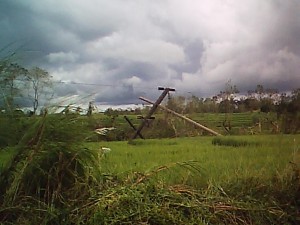
Kalinga is one among the hardly hit province by super typhoon Juan on October 17 to 19, 2010. The province was under signal # 1 on October 17 then on the early morning of October 18, Kalinga was under Signal #3 then just a few hours it was under signal #4. On October 19, it was under signal number 2. The strong winds with few rainfall was experienced on the late afternoon of October 17, 2010 but in the morning of October 18, 2010, the winds became stronger accompanied by heavy down pour of rains which lasted up to the early morning of October 19, 2010.
At midday in October 18, 2010, Juan’s rage was felt throughout the province; the strong winds and rainfall caused the Chico River and other river systems to swell which flooded the communities and rice fields near the riverbanks. The trees and electric post were uprooted or fallen, roofing materials of houses, waiting sheds, school buildings, pig pens and other building were blown by the winds and fruits of fruit -bearing trees fell down. As the electric post fell down, communication lines cut down and there was total power shot down all over the province.
Series of landslides occurred along the major road networks. First to close was the Gonogon Section of the Tabuk-Bontoc Road, then small landslides and fallen trees also happened from Gonogon Section up to Tinglayan. Other major roads that closed included Balbalan –Pinukpuk, Tabuk-Paracelis, Junction Pinukpuk-Wagud and Pasil –Balbalan. The municipalities in Upper Kalinga are isolated and beyond reach due to closure of roads and damaged communication facilities until now (Oct. 23, 2010)
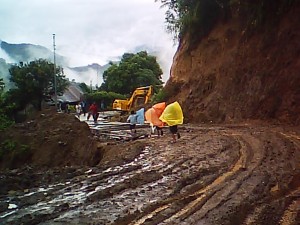
In Lowland Tabuk, pre-emptive evacuation was done on October 17 PM. Residents along the Chico River and low-lying communities evacuated to Tabuk Gym and Laya East Elementary School. The evacuees composed of 270 families (1,225 individuals) came from Appas, Cabaruan, Calanan, Dagupan Weste, Lanna, Laya East, Magsaysay, San Juan and Sucbot. Families who evacuated to houses of their relatives were not accounted.
Based on reports from the City Disaster Risk Reduction and Management Council of Tabuk as of October 19, 2010, 124,354 individuals were affected in Tabuk. There were significant damages to infrastructures such as irrigation systems, roads, bridges, public buildings and other structures with still undetermined amount. Residential houses were not spared, there were 5,466 partially damaged houses and 1,587 totally damaged. Most of the totally damaged houses were made of light materials. Some sturdy houses were partially damaged.
Data obtained from National Disaster Risk Reduction and Management Council (NDRRMC) on October 23, 2010 revealed that province wide, there were 37,019 families (213,208 individuals) affected from the eight (8) municipalities of Kalinga. 314 families from Tabuk and Rizal were evacuated to evacuation centers. Most of the evacuees returned to their Barangays but there are still 28 families who are living with relatives because their houses were totally damaged. There was 1 casualty in Babalag, Rizal who was pinned down by fallen trees and 6 persons injured (1 each from Tabuk and Pinukpuk and 4 from Rizal).
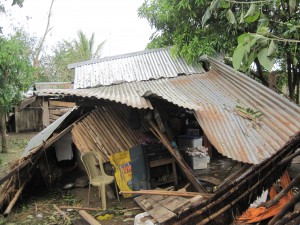
As to damage houses, 1,757 houses were totally damaged and 9,511 partially damaged with Tabuk, Rizal & Pinukpuk having the biggest number of families with damaged houses. There were also 4 school buildings damaged with estimated cost of 3.2 million pesos.
Total land area devoted to rice, corn, and high value cash crops affected was 520 hectares with production loss of more than 39 million pesos. Generally, palay at fruiting stage and about to be harvested was mostly damaged. Affected families are distress for lack of food in the coming days and months due to loss of rice harvest.
As of October 23, 2010, power supply for whole province is still not yet restored.
Province of Ifugao
Ifugao was one among the 4 provinces in the Cordillera that was under signal #4 on October 18, 2010. Geographically, Ifugao is near to Isabela where Typhoon Juan had its landfall so it has almost the same damaged suffered by Isabela. There were 63 barangays and 1,135 families affected with 2 casualties (1 each from Tinoc and Hingyon). There were 322 partially damaged houses and 69 totally damaged houses with Aguinaldo having 119 partially damaged and Alfonso Lista with 55 totally damaged houses.
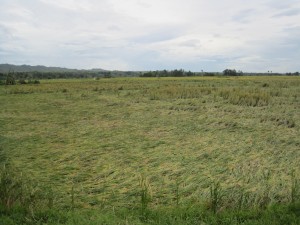
DA Regional Director Alviar Jr. said that Ifugao was the most affected in terms of rice production among the Cordillera provinces with 1,880 hectares of about to be harvested palay had been damaged. Other damaged crops were corn, vegetables and fruit trees. The estimated value of damaged crops is near to 300 million pesos. Aguinaldo, Alfonso Lista and Lagawe incurred the biggest loss in terms of damages to crops. Damages to livetocks and fisheries have already reached more than 6 million pesos.
Roads are still closed, on-going restoration by DPWH for Banaue-Hungduan Rd., Banaue-Mayaoyao-Aguinaldo-Isabela rd., Nueva Viscaya-Ifugao Rd., and the Bontoc-Banaue Rd. Aside from damaged roads there were reported 14 school buildings that were damaged.
Power supply for Aguinaldo, Hungduan, Mayoyao and Tinoc is still off. Restoration is affected by landslides along roads leading to the said municipalities.
Province of Apayao
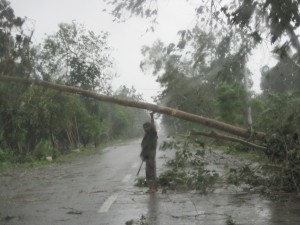
Apayao roads were closed before midday on October 18, 2010 due to landslides and road obstacles such as fallen trees and debris carried by strong rains and winds. The rage of Typhoon Juan affected the whole province but the municipalities mostly affected were Pudtol, Kalanasan, Conner and Kabugao.
In Kabugao, there were 200 partially damaged houses and 50 totally damaged houses followed by Conner, Pudtol, Sta. Marcela and Kabugao with more than 200 partially damaged houses. Province wide, the total partially damaged houses was recorded at 1,089 and 58 totally damaged houses.
The road connecting the province to Cagayan and other provincial roads were closed such as the Claveria-Calanasan and Lenneng-Kabugao due to overflowing of the Maranas River and landslides.
Crops and infrastructures were also greatly damaged in Apayao. According to NDRRMC, as of October 22, 2010, the estimated loss in crops is 250 million pesos.
The municipalities of Conner, Calanasan and Kabugao have no power supply up to this date.
Mountain Province
The province was not spared by Typhoon Juan; on October 18, 2010 it was under signal #4. Juan was considered one among the strongest typhoon that hit the province with very strong winds. There was also strong rain but tolerable as compared to typhoon Pepeng. Though very strong, destruction to life was prevented because pre-emptive evacuation was done before the height of the typhoon. 126 families from Tadian were evacuated to church buildings for safer dwelling.
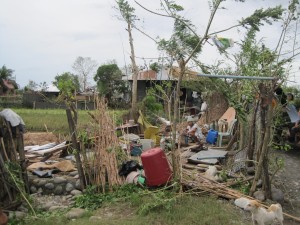
Paracelis, the nearest municipality of Mountain Province to Isabela has the highest number of destroyed houses. There were 150 totally damaged and 1,000 partially damaged houses. All through out the province, there were 158 totally damaged houses and 1,079 partially damaged houses. An old female resident in Bantay, Paracelis was injured when she was struck by falling tree during the height of Typhoon Juan.
In Sagada, 27.82 hectares planted with vegetables & fruits ready to harvest was affected. There were eroded ricefields in Ambasing, Tanulong, Kilong and Taccong. In Dagdag there was washed out rice fields. Amount of these damages are still to be assessed and validated. NDCC reported that the estimated loss to crops is 42.8 million pesos. One school building was reported damaged with estimated cost of 50,000.00 pesos.
Paracelis and Natonin power supply is not yet restored until today. The crew of MOPRECO can not reach the 2 municipalities due impassable roads. As mentioned earlier, there were series of landslides along the stretch of Bontoc-to Paracelis road which is more than 75 kilometers.
Abra
The highest typhoon signal recorded by PAGASA for the province of Abra during the 3 days lingering of Typhoon Juan in the Cordillera Region was #3. Though the damages in the province was not as huge compared to the other provinces, Abra still incurred significant damages especially in the municipalities of Lacub, Malibcong and Tubo. From these 3 municipalities, there were 112 partially damaged houses and 3 totally damaged houses. Families with damaged houses temporarily evacuated to safer homes of their relatives while houses that are partially damaged are being repaired by affected families.
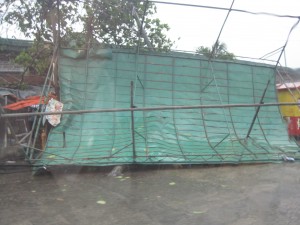
Initial report showed that rice crops that are about to be harvested on November were destroyed due to strong winds and flooding. Estimated amount of damaged palay is 1.7 million pesos. The estimated damaged to crops is 3.6 million pesos.
Roads leading to upland municipalities were impassable by vehicles due to swelled rivers and creeks crossing the roads and series of landslides. The Kalinga-Abra road and the Abra-Cervantes Road are still closed. The difficulty of transportation isolated the municipalities in upland Abra. Moreover, supplies of basic communities especially food are beginning to deplete in stores and houses.
Benguet
When Typhoon Typhoon entered PAR on October 17, 2010, the weather was still fine; there was no sign for a strong typhoon to come. Typhon Signal #1 was declared in Benguet on October 17, 2010 but in the early morning of October 18, 2010, the province was under TS #3. There were already strong winds with few rains in the morning but as the hours passed, winds became tougher and the downfall of rain is increasing. The situation remained up to midnight of October 18, 2010, at this time the eye of the storm was spotted somewhere in Atok, Benguet towards La Union. It was observed that the direction of the winds changed, from northwest it turned northeast and the rainfall became higher. Though Benguet was put under TS#1 at 5AM on October 19, 2010, the strength of wind and rainfall did not changed until evening. Mild winds and rains continued up to October 20, 2010.
The whole province was affected by Juan, there were reported 251 damaged houses with 245 partially and 6 totally damaged houses mostly from Sablan and Tuba. There were 6,196 families affected with 1 casualty from La Trinidad due to electrocution and 5 persons injured. More or less 400 families evacuated due to endangered houses, some communities in Itogon, Tublay and La Trinindad that were previously hit by typhoon Pepeng last year had pre-emptive evacuation prior to the onset of the strong winds and rains.
The farmers are deeply saddened by Typhoon Juan because most of the crops were badly damaged. Some of the salvaged vegetables were not transported to market outlets due to closed roads. Farmers who were able to bring their farm products to La Trinidad Trading Post waited until October 20, 2010 before their products were disposed because traders from the lowland resumed buying vegetables after the typhoon weakened and the roads opened. In Tublay, its Local Chief Executive estimated loss to crops was near to 60 million pesos. Cut-flowers ready to harvest for the All Saints Day were damaged, the green houses were blown by the strong wind. As of October 21, 2010, the estimated agricultural loss in the province is more than 200 million pesos.
Meanwhile, the 2 dams in Itogon (Binga and Ambuclao) released water from the dam gates because it already reached the critical level. The released waters are accumulated to a bigger dam at San Roque, though it did not yet reached its critical level, the continuous rain triggers accumulation of rains in the 3 dams that may fill the San Roque Dam.
Bakun, Bokod and Kibungan power supply is still being restored.
In Labey, Bokod, one of the communities ravaged by Typhoon Pepeng last year was less affected this time. There was minimal damaged in agriculture (especially in beans and banana tree). Most of the community people had their crops harvested before the Typhoon came. Though typhoon Juan affected the water system in the community, most of the water hose going to the houses were damaged because of the strong winds. The mobility of the people in sitio Panganan with 35 families is affected because they cannot cross the river due to the strong water current. However according to the chairperson of LIPCA the water current slowly weakened and the swelled water already subsided. Minor landslides were observed in the area. There was no electric power in the area and the school is still closed.
Baguio City
Baguio City experienced the same strength of Typhoon Juan with Benguet. There were 40 barangays and 532 families mostly affected with 1 recorded casualty and 3 injured persons. 341 families evacuated mostly coming from City Camp Lagoon area. There were 3 totally damaged houses and 21 partially damaged houses.
Baguio City also experienced total power shut down on October 18, 2010. Restoration of lights was done on the following day. As of October 22, 2010, 80% of the city has power; the remaining 20 % is still being restored by BENECO. Power restoration is difficult due to fallen trees that destroyed power lines. In the city proper there were 63 fallen trees.
CDRDS had relief delivery operations on October 22, 2010 to Kias evacuees numbering to 10 families. Delivered goods are food and non-food. These families are temporarily staying at the Day Care Center because their houses are endangered due to loose soil, at day time they are in their residential houses fixing damages and clearing landslides but at night time they return back to the center.
Report from: CDRDS

Leave a Reply